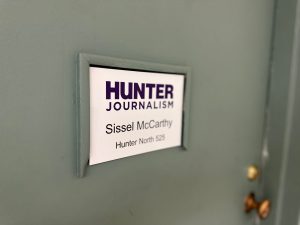The journalism department at Hunter is ranked among the top 50 journalism schools in the United States and the top five in New York, according to 66 metrics of assessment.
While journalism is a vast field with many different paths to go down, it’s not a surprise there are numerous opportunities for students to note which courses appeal to them, and which don’t.
However, having numerous options might come off as intimidating. Students might feel the immediate pressure after graduation to have it all “figured out,” but even Professor Sissel McCarthy, didn’t know she wanted to become a journalist until her second career.
Prof. McCarthy has been a part of the Hunter community since the 2015 fall semester.

Since her start at Hunter, there have been nine newly added courses to the journalism concentration and even a journalism minor. The courses that she has added to the major are multimedia. It prepares students for the reality of modern-day journalism today, which is multi-platform reporting. According to Prof. McCarthy, “Everyone needs to know how to report online, on the radio, for TV, and on social media.”
Prof. McCarthy says the curriculum as a whole has been revamped to give students the skills to succeed in this new digital world of journalism. Now at Hunter, there are courses like radio recording and podcasting, and mobile journalism.
She and her team have even added studio news production. This class is where hunter news is broadcasted as a bi-weekly show, produced only by journalism students who anchor, report, and produce the newscast by themselves.
There are even some new courses like Social Justice Journalism, urban health, and environmental reporting. These are two upper-level classes for students who really want to dig in on a beat. There is even data journalism. This is a course that is normally only taught at the graduate level, but she wants students to be able to use and scrape data, then develop story ideas from that, and then be able to visualize that data for people by creating graphics.
A great way to get a foot in the door of the journalism field is the News Literacy course, which is the most popular course this semester at Hunter. There are 10 sections, which is the most the school has had, and there are 160 students.
Prof. McCarthy likes to call it a “gateway course into the major.” Students might not necessarily know if they want to pursue a journalism major, but can still gain the life skill of being able to determine what information they can trust and where to find it.
Pamela Rozon is amongst the Hunter journalism community, and although their interest lies in reporting on issues like low-income communities and environmental studies, being able to use some of the skills they’ve gathered from other courses and apply them to their writing gives them motivation. “I enjoy what I do so engrossing myself in reporting helps a little.”
Having professors who have also worked in the industry can also make it a little easier for students to trust the process. Rozon says, “It feels nice knowing that it’s possible to have a good job in journalism, and our teachers are proof of that.”
If a student has a journalism degree, and decides, “I really don’t want to be a journalist anymore,” Prof. McCarthy’s advice is “Don’t worry and don’t feel lost.” She suggests students have to show off their critical thinking skills, the ability to evaluate and analyze information, and the ability to communicate. Those are skills that they can apply, and use to really stand out in a host of other jobs.
It is a never-ending flow of information to the public that journalists provide to keep them informed of current events and the rest of society. Journalism includes a wide range of topics. They also give the public access to global issues and potential solutions. For Hunter students, getting a hands-on experience in newsroom and creative style journalism strengthens their writing and may even give them an idea of which specific path they would like to go down.

